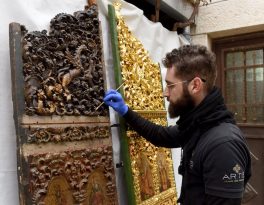By Judith Sudilovsky, Catholic News Service
BETHLEHEM, West Bank (CNS) — When restoration on the Church of the Nativity’s wooden beams and leaking roof began in 2013 with the blessing of the three custodial churches, everyone involved was aware of the historic significance of the venture. It was the first time in 540 years that any repair work was done on the church on the site where Jesus was born.
But what the team of workers — including local Palestinian committees and engineers and international restoration experts — did not know was the true impact of the initial ecumenical cooperation.
Historically the Franciscans, Greek Orthodox and Armenians jealously guarded their rights in the church, under the 1852 Status Quo agreement that regulates the ownership of spaces in various holy sites as well as the times and duration of religious liturgies. As recently as 2011, Greek Orthodox and Armenian monks came to blows over cleaning rights in a certain area in the church.
But with the leaking of the roof endangering the ancient structure, all agreed to undertake the necessary work.
And a new era began.

“Along the way the three churches noticed the good results that were coming from the cooperation and that it would be good to continue,” said Khouloud Daibes, the new executive director of the Bethlehem Development Foundation, which has raised $2.6 million out of the $15 million needed for the restoration of the entire church.
“At first it was just supposed to be the roof, but then we continued to do much, much more,” she said.
The project required coordination involving more than 400 specialists and the need to maintain the liturgical schedule and to keep the doors open for pilgrims, she said.
Imad Nasser, an engineer and technical representative of the Palestinian Presidential Committee for the Restoration of the Nativity Church, said safety requirements for visitors have been challenging, because the church remained opened throughout the restoration process.
After a process of extensive studies and negotiations, the project gradually grew to a more comprehensive endeavor and included restoration of Crusader-era frescos and wall and floor mosaics, which had been dulled by centuries of pilgrims burning candles and incense smoke; restoration of the outside facades; and restoration of the 50 marble columns inside the church, each one dedicated to a different saint.
Franciscan Father Ibrahim Faltas, representing the Custody of the Holy Land, told Catholic News Service: “This project has brought the three heads of churches closer and improved the relationship. In fact, the three heads of churches agreed to implement rehabilitation work at the Church of the Holy Sepulcher in Jerusalem. We hope that this cooperation will continue in the future.”
Claudette Habesch, a member of the presidential committee for the restoration, said the ability of the churches to come together with a shared goal of restoring and protecting the church is not only a symbol of hope for Christianity, but should be a message to all people of the Holy Land. She said it was in line with Pope Francis’ 2020 social encyclical, “Fratelli Tutti,” which urges people to act as neighbors for the common good, rejecting the creation of a society of exclusion.
“This is a great achievement. This goes beyond the physical achievements … not only for Christians but for everyone one who lives here,” Habesch said. “It gives us hope that we can also work on reconciliation and peace in this land.”
Dependent on donations mainly from supporters from abroad, the restoration project has been carried out in several phases, with the COVID-19 outbreak severely reducing the amount of funds available and slowing down work.
The remaining work includes a firefighting system, a micro climate system, and restoration of the grotto itself.
Mazen Karam, outgoing CEO of Bethlehem Development Foundation, said if all the needed funding were secured immediately, the entire project would be completed around 2023.
The project also encouraged the three churches to undertake restoration work on their own private sections of the church, he said, and so most of the entire complex has been restored.
Currently, on the initiative of the Greek Orthodox Patriarchate of Jerusalem, two art conservationists have been working on the Greek Orthodox chapel’s iconostasis, a wall of icons and religious paintings that separates the main part of the chapel from the sanctuary.
“It is a privilege to work here and watch the three different churches praying in one place. It is not an experience I could have in any other place,” said art restorer Zacharias Zacharoudis.
While most pilgrims are not yet able to come to Bethlehem, a traveling exhibit of the restoration project was inaugurated at the Vatican Museums in 2019 and is currently being shown in Cologne, Germany.






















